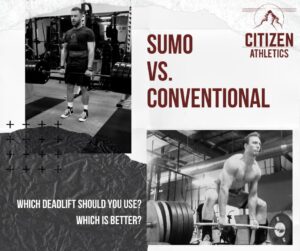Deadlifting is one of our favorite categories of exercises.
It brings a lot of return for a relative amount of simplicity: pick something heavy up off the ground.
If you’re looking for one movement that challenges a vast majority of your body and is relatively simple – the deadlift should be your top choice.
Through the hip hinge action we can develop a strong posterior chain: glutes, hamstrings, and spinal erectors.
However, the variation of deadlift that we do can influence whether we emphasize certain muscles over others, build different strength adaptations, and much more.
The two main variations of deadlift – conventional and sumo – have a ton of similarities.
-
Hinge type movements where we emphasize hip motion over knee motion.
-
Strengthen the entire posterior chain
-
Utilize a barbell in front of the athlete that forces the athlete to fight forward motion
-
Challenge the athlete to create both horizontal and vertical force.
We could keep going, but you get the point, we love deadlifts.
While there are all of these similarities, there are obvious differences between the movements.
In deciding which to do, we need to really consider why you’d be choosing between them.
If you’re a competitive deadlifter, you’re going to want to generally be performing the one that is your stronger movement.
This will allow you to practice the technique and build strength in the motion.
For most competitive lifters, spending some time further away from meets doing the other variation can be beneficial in shoring up weak links.
In particular we can utilize the other deadlift style to be a great supplement in developing a stronger deadlift in general, and usually also help build your squat.
As you get into meet prep though, we would generally remove it and stick with the competitive stance primarily.
If you aren’t a competitive deadlifter, then deciding which of the two really comes down more to what you want to get out of it.
Are you looking for general strength? Are you looking for a stronger back? Are you looking for stronger thighs? Are you trying to build strength to transfer to a certain activity?
These should be what you use to decide then which variation you should most commonly use.
Once you’ve considered that, then you can start to examine which matches most up with your goals. Here are a few of the major differences between them to help you decide:
-
Sumo has your foot placement outside your arms vs conventional inside your arms
-
Sumo will be more quad dominant than conventional
-
Sumo is going to be more demanding on your adductors
-
Conventional will be more back dominant than sumo
-
Conventional will generally require more hip flexion than sumo
-
Sumo will require more hip external rotation and hip abduction than conventional.
-
Conventional strengthens more sagittal plane force development
-
Sumo strengthens more frontal and transverse force development
Some of these details can be really valuable to consider – such as the planes of force developed for different sport athletes.
As well, due to the greater hip flexion aspect of conventional, it generally requires a more bent over position, whereas sumo can be adjusted to be more upright with the hip external rotation and abduction demands.
This is valuable for those who tend to be more sensitive to bent over positions and struggle with a history of challenges trying to deadlift.
Consider the prior information about what you’re looking for out of it and then use that to help you decide.
Let us remind you though that there is definitely merit in performing both movements periodically.
Most people will find that doing one will get gradually have diminishing returns and switching over to the other can help give a refreshing stimulus to help push your strength/hypertrophy gains back up.
If you follow our programming, we are always open to you swapping sumo out for conventional or vice-versa, customize the details to match what goes best in line with your goals!
The Citizen Athletics Team,
Sam


